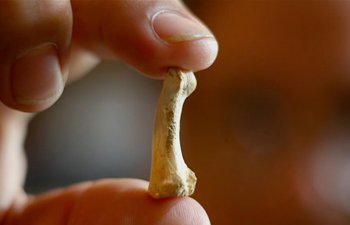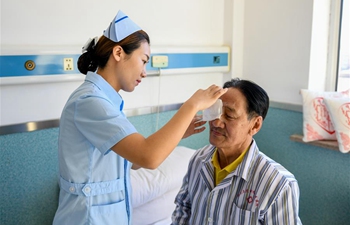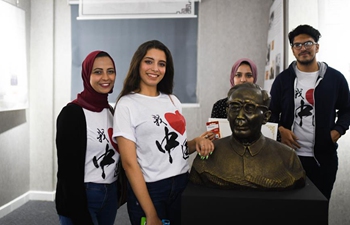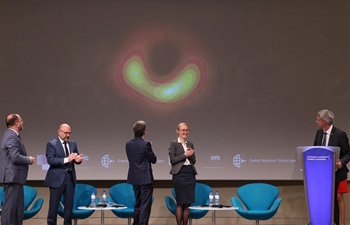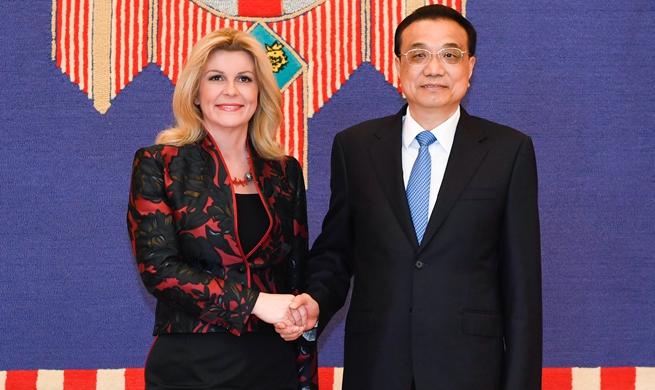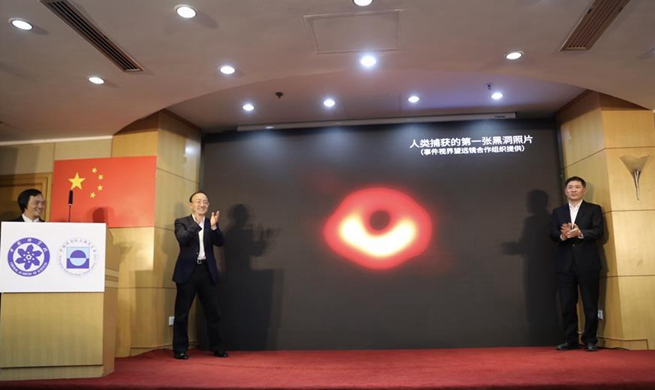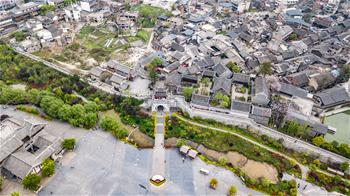by Stefania Fumo
ROME, April 11 (Xinhua) -- Italian scientists have succeeded in adding tactile sensors to the artificial hand of RoboSimian, a robot that carries out rescues in cases of accidents or natural catastrophes, researchers have announced.
The researchers are from the BioRobotics Institute at Italy's prestigious Sant'Anna School of Advanced Studies located in the Tuscan city of Pisa.
Created by robotics teams at NASA's Jet Propulsion Lab (JPL), RoboSimian is a four-legged robot designed to look and act like a primate -- the visual reference was a panda bear -- that can go into action in cases of disasters or natural calamities, minimizing the exposure of human rescuers to danger.
TACTILE SENSOR TECHNOLOGY
Unlike many other robots that specialize in just one or two tasks, RoboSimian can complete a wide array of tasks such as opening doors, navigating complex terrain, clearing debris, and performing repair work during emergency situations.
"RoboSimian can intervene in emergency situations and has two main functions: to lift heavy objects, and to interact with the human world," explained JPL researcher Kalind Carpenter. "The sensorized hand allows for more effective control of objects and more developed interaction with humans."
The robot's hand can now "perceive" the physical properties --- such as size and consistency --- of what it touches, and it can also pick up objects and adjust its fingers around them without dropping or destroying them, thanks to integrated fiber-optic sensors.
This will allow the robot to interact with humans in emergency situations, according to the scientists at Sant'Anna's Neuro-Robotic Touch Lab, which is a part of the school's BioRobotics Institute.
"The hand has been sensorized to perceive the physical properties of the objects it manipulates --- from cylinders of different sizes and materials, to a balloon to a potato chip," lead researcher Luca Massari explained.
"In the last few years, the field of robotics has expanded toward more complex environments, including dangerous and inaccessible scenarios such as nuclear meltdown disasters and space missions to other planets, where robots are demanded to take over human jobs," Massari wrote in his findings.
The next step, said Sant'Anna researcher Calogero Oddo, who coordinates the Neuro-Robotic Touch Lab, is to test RoboSimian and its sensorized hand outside the lab, in daily life scenarios or in an emergency or rescue context.
"The objective is for a robot with tactile sensors to carry out operations that humans can't -- for example, in the case of an underwater oil pipeline spill, where the oil impedes visibility," Oddo told Xinhua.
"In general, a robot with a prehensile hand equipped with tactile sensors is capable of executing operations in low visibility contexts, or in contexts where a higher level of precision is needed in order to avoid damaging surrounding objects or people," said Oddo.
He will be presenting the team's findings at the World Smart Systems & Micromachine Summit in the northern Chinese city of Xi'an on May 25.
MORE COLLABORATION
Oddo explained that his group's research into tactile sensor technology originated in medicine. "We started from prosthesis research, trying to give the robot hand tactile sensation so that an amputee, for example, can feel objects he or she picks up with their artificial hand."
Sant'Anna's Neuro-Robotic Touch Lab and its Translational Neural Engineering Area Lab first made international headlines in 2016, when they announced that they had developed an artificial fingertip that provides tactile feedback to the user, and that a man who lost his hand in accident had been successfully implanted with bionic tactile sensors, recovering the sense of touch.
Amputee Dennis Aabo Sorensen, a Danish national, took part in a clinical trial and had nerves surgically connected to the "bionic" fingertip, allowing him to experience feeling and distinguish between various surfaces.
The research was carried out by Italian and European partners and published in science journal eLife. Sorensen became the first person in the world to recognize texture using a bionic fingertip.
"The subject was surgically implanted with electrodes in his upper arm, which transformed information recorded by artificial touch sensors into signals that were conveyed to the nerves, and therefore into sensory information interpreted by the brain," Oddo explained.
Oddo added that the next frontier is to develop tactile sensors for robotic surgery, endowing surgeons using robots for high-precision operations with a sense of touch as well as sight.
"This technology doesn't exist yet," Oddo said. "We have some prototypes, and our hypothesis is that we can improve the quality of the surgeon's gesture even more by adding tactile sensors as well as visual ones".
Oddo went on to say that the Neuro-Robotic Touch Lab is developing this technology for its own robots as well as those of other institutions.
"Our lab develops sensors, and we set up partnerships with whoever has a proposal, as we did with our NASA colleagues," Oddo explained.
"In theory, we are ready to develop collaboration with anyone who has a robot -- we have ongoing technological development plans with businesses as well as academic, industrial and scientific partners," he said, adding that "as a school, Sant'Anna has a very strong collaboration with China".
Indeed, the Sant'Anna School of Advanced Studies has bilateral conventions with universities around the world, including in the Middle East, Africa, and Asia.
In China, it collaborates with Chongqing University and Zhejiang University in the field of industrial engineering. It also has conventions with the China Southwest University of Political Sciences and Law in Chongqing, Henan University in central Henan Province, and the China University of Political Sciences and Law in Beijing, according to its website.
The results of the RoboSimian study, a joint project with NASA's JPL, the Italian Institute of Technology (IIT), and Ca' Foscari University in Venice with financing from Italy's ministry of education and the Dubai Future Foundation, were published in the April 5 issue of Frontiers in Neurorobotics scientific journal.
